Set the wheels spinning: 'Cycle Revolution' at the Design Museum
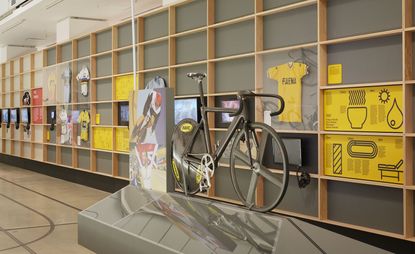
The contemporary cycling boom has – depending on your level of interest – either re-popularised a superlative machine, or merely transformed the British landscape into a sea of overstuffed lycra. Either way, it's a phenomenon; spurred on equally by the Olympic and Tour successes of Wiggo, Hoy, Froome et al, and initiatives like the government's Cycle to Work Scheme (the perfect combination of illusory bargain and legal tax avoidance).
Given this, the Design Museum's current exhibition on velo-design and contemporary cycling culture, 'Cycle Revolution', feels both overdue and a little underwhelming. It looks lovely, of course: from the vertiginous tree of patina'd frames that stretches up the museum's stairwell, to the wraparound wall of mounted cycles, the visual curation is every bit as impressive as you'd expect.
Rather, it's the concept that jams the brakes on. In what feels like an attempt at comprehensiveness (a tough ask given the topic), the show is organised into four thematic 'tribes': 'High Performance', 'Thrill Seekers', 'Urban Riders' (in this instance, commuters) and, randomly, 'Cargo Bikers'. It's an overly broad scope which leaves the show anchorless; a mish-mash of (admittedly impressive) bits-and-pieces without a defined core.
'High Performance' is the strongest section by some distance and carbon-heads will doubtless be awestruck by the inclusion of myriad medal-winning models (from Chris Boardman's Lotus Type 108, Chris Froome’s Victory Team Sky Pinarello and David Millar’s Rennie Mackintosh-inspired Commonwealth Games Cervélo among them). In a largely Anglo-centric selection – understandable given the British dominance of the sport over the past decade – it's also nice to see the inclusion of Eddy Merckx and Francesco Moser's Hour Record bikes from 1972 and 1984, respectively (and the visual segue from Merckx's retro steel fixie, through Moser's chromed lo-pro and on to Wiggins' space-age Pinarello Bolide HR is enlightening). The darlings of Team Sky are an inevitably looming presence – an expansive infographic on 'What it takes to win a Tour' and a short film on the team are particularly insightful.
There's little on street and fixie culture here, but steel enthusiasts should be sated by the aforementioned Merckx number, as well as the enclave (replete with in-progress frames, unpacked boxes of loose Columbus tubing and Brooks saddle stools) dedicated to artisan and independent makers such as Mercian, Donhou and Toad, each explored in documentary form.
Similarly, trials, mountain biking and BMX racing are under-represented, having still not attained the glamourous cache that road racing has seen in its resurgence. Go-to names like Shanaze Reade, Danny MacAskill and Martyn Ashton are factored – and there's thoughtful coverage of the Peckham BMX Club community youth scheme – but that's pretty much your lot. There's also a Raleigh Chopper, because no cycling exhibition is complete without one, apparently.
After tracking onwards through commuter vehicles (Bromptons, Moultons, Stryders etc), cargo and 'Future Bikes' (think a variety of dropped top tubes, recumbent and conventional takes on cycle design in alternative materials, though the space also includes information on cycling infrastructure in nine global cities), the show culminates in a movie of testimonials from such luminaries as Paul Smith, Norman Foster and Brompton boss Will Butler Adams. ‘Cycling to me means freedom,’ the latter concludes. ‘That feeling hasn't changed.’ It’s an essential, existential sentiment, briefly summing up what makes the humble bicycle such a precious machine to so many – though one which 'Cycle Revolution' fails to truly harness outside of these final moments.
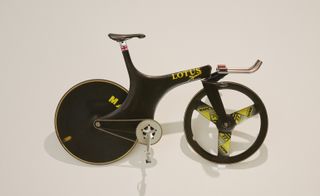
The show is organised into four thematic 'tribes': 'High Performance', 'Thrill Seekers', 'Urban Riders' (in this instance, commuters) and, randomly, 'Cargo Bikers' – the former is the strongest section by some distance. Pictured: Lotus Type 108, Barcelona Olympic games, 1992

Welcome inclusions are Eddy Merckx's 1972 Colnago Hour Record bike...

... and Francesco Moser's 1984 equivalent – a chrome lo-pro, now owned by Sir Bradley Wiggins
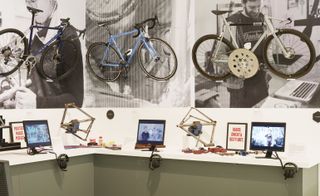
Steel enthusiasts should be sated by the enclave dedicated to artisan and independent makers such as Mercian, Donhou and Toad, each explored in documentary form
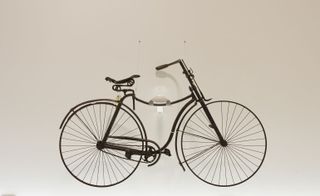
An 1880s safety bicycle is the oldest model on show. Pictured: Rover Safety Bicycle, c. 1888
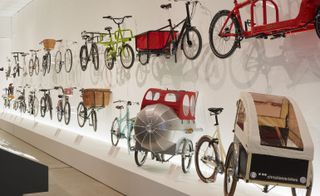
The show tracks onwards through commuter vehicles (Bromptons, Moultons and Stryders among them) and cargo bikes...
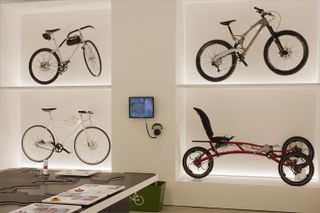
... culminating in a 'Future Bikes' exhibit (think a variety of dropped top tubes, recumbent and conventional takes on cycle design in alternative materials, though the space also includes information on cycling infrastructure in nine global cities) and a short film of testimonials from bike-obsessed makers, designers and architects
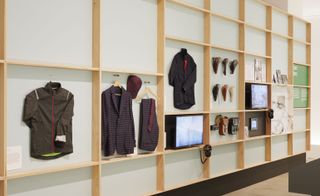
The show pays some attention to the sartorial side of cycling, from Paul Smith-designed racing jerseys, to more urbane commuter-wear
INFORMATION
’Cycle Revolution’ is on view until 30 June 2016. For more information, visit the Design Museum’s website
Photography: James Harris
ADDRESS
Design Museum
28 Shad Thames
London, SE1 2YD
Wallpaper* Newsletter
Receive our daily digest of inspiration, escapism and design stories from around the world direct to your inbox
-
 Gucci’s ‘Design Ancora’ reimagines furniture classics in rich red
Gucci’s ‘Design Ancora’ reimagines furniture classics in rich redGucci launches new editions of Italian design icons in an alluring deep red, showcased during Milan Design Week 2024
By Simon Mills Published
-
 Loewe’s Jonathan Anderson drafts artists to create 24 extraordinary lamps at Milan Design Week 2024
Loewe’s Jonathan Anderson drafts artists to create 24 extraordinary lamps at Milan Design Week 2024Loewe creative director Jonathan Anderson commissioned international artists and artisans to explore ‘illumination within the house’ with a series of lamps and lighting installations, shown at a group exhibition at Milan Design Week 2024
By Scarlett Conlon Published
-
 What are polynucleotides? Trying the skin injectable made from salmon sperm
What are polynucleotides? Trying the skin injectable made from salmon spermPolynucleotides are the latest in skin injectables, containing DNA derived from the gonads of salmon. Wallpaper* Beauty & Grooming Editor Hannah Tindle tries them to discover exactly how they work
By Hannah Tindle Published
-
 Saul Steinberg: behind the scenes at Triennale Design Museum
Saul Steinberg: behind the scenes at Triennale Design MuseumTriennale Design Museum and publishing house Electa present ‘Saul Steinberg Milano New York’, a new exhibition (until 13 March 2022) that pays homage to the American artist through 350 works. Join us for a behind-the-scenes peek at it's installation
By Rosa Bertoli Last updated
-
 Ten years of Muller Van Severen, at Design Museum Ghent
Ten years of Muller Van Severen, at Design Museum GhentA new exhibition by Belgian design duo Muller Van Severen (until 6 March 2022) features a retrospective of the studio’s ten years as well as a curation of pieces from the Design Museum Ghent collections
By Rosa Bertoli Last updated
-
 Noguchi show celebrates his reverence for Greece
Noguchi show celebrates his reverence for GreeceDesign show ‘Objects of Common Interest: Hard, Soft, and All Lit Up with Nowhere to Go’ opens in collaboration with Wallpaper* Designers of the Year, Objects of Common Interest, at the Noguchi Museum in Queens, New York (until 13 February 2022)
By Tilly Macalister-Smith Last updated
-
 ‘Design not for children, but for everyone’: Jewish Museum Berlin’s new play space
‘Design not for children, but for everyone’: Jewish Museum Berlin’s new play spaceOlson Kundig architecture and design practice brings kids’ play space ANOHA Children’s World to life inside a vast former wholesale flower market, at the Jewish Museum Berlin
By Hannah Silver Last updated
-
 A landscape of playful animals pops up at Design Museum Holon
A landscape of playful animals pops up at Design Museum HolonChild-centric designer Sarit Shani Hay presents an imaginary natural landscape that references Ron Arad's Design Museum Holon architecture and is inhabited by soft, cushioned sea lions, seals and bears
By Rosa Bertoli Last updated
-
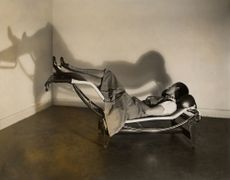 Charlotte Perriand’s life and work explored at London’s Design Museum
Charlotte Perriand’s life and work explored at London’s Design MuseumLondon’s Design Museum presents ‘Charlotte Perriand: The Modern Life’, an exhibition turned the spotlight on one of the most iconic creators of the 20th century
By Rosa Bertoli Last updated
-
 Meet the Design Museum’s all-female Designers in Residence
Meet the Design Museum’s all-female Designers in ResidenceThe multidisciplinary cohort includes Enni-Kukka Tuomala, Abiola Onabule, Cynthia Voza Lusilu and Ioana Man, who developed a series of multidisciplinary projects with the Design Museum, responding to the theme of ‘Care'
By Rosa Bertoli Last updated
-
 Campana Brothers look back on 35 years of revolutionary design
Campana Brothers look back on 35 years of revolutionary designOn view at modernist Museum of Modern Art in Rio de Janeiro, ‘Campana Brothers – 35 Revolutions’ is a retrospective of the Brazilian designers’ impactful oeuvre
By Rosa Bertoli Last updated